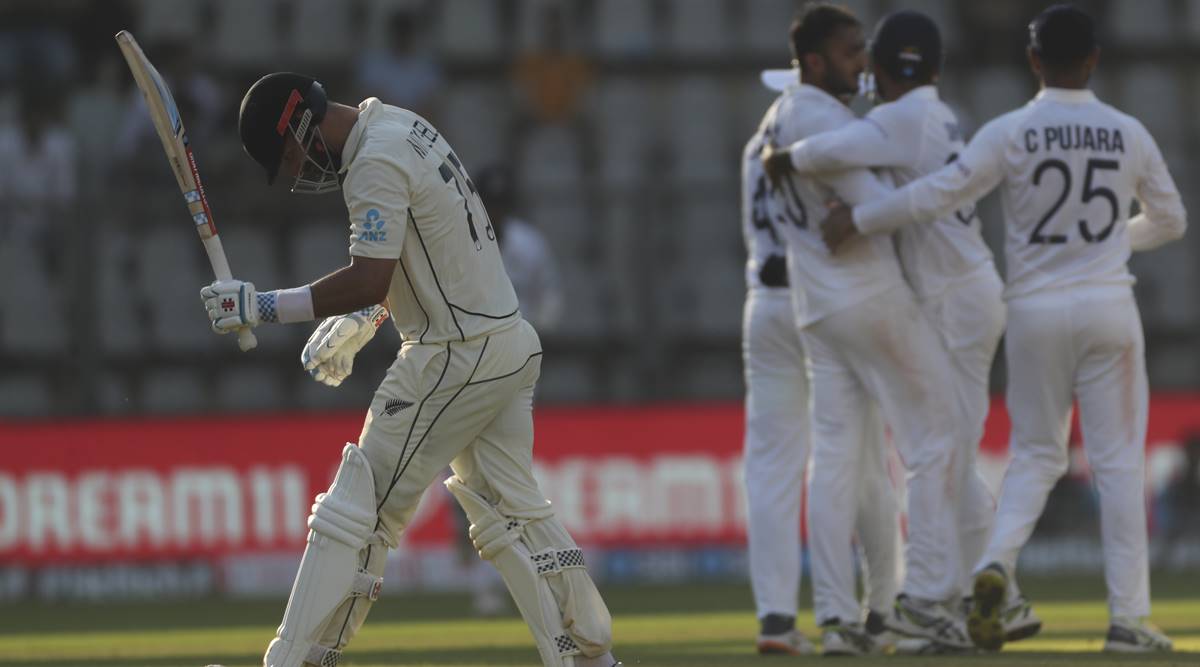Shared News: December 7, 2021 8:18:09 am
New Zealand’s Kane Williamson looks on during second Test. (AP Photo)
In the third over on the fourth morning of the Mumbai Test, Rachin Ravindra got a couple of half-trackers from Jayant Yadav and dispatched them to the cover boundary. New Zealand needed close to 400 runs to win at that stage, but nevertheless, Virat Kohli pushed a man back to prevent any further fours to that region. Kiwi stand-in skipper Tom Latham said after the match that subcontinent teams pull out close-in fielders as soon as you hit a few, and that had been New Zealand’s plan.
An aggressive approach on paper, but one that hastened the end of the match only 43 minutes into the first session of the fourth day. Half of the New Zealand wickets in the second innings came when batters tried in vain to put pressure in their own ways on the fielding team.

New Zealand’s Tom Blundell loses his wicket. (AP) Ross Taylor’s top-edged slog-sweep on the third evening has grabbed the most attention considering his suicidal approach didn’t sit well with his stature, but Daryl Mitchell and Henry Nicholls were two more specialist batters who departed trying to force matters. When asked if everyone in the batting line-up had shown fight, Latham said they had. “I think so. In these conditions, you can’t just allow them to bowl,” Latham said. “They’re very good, very accurate and they don’t give you much. For us, it’s about trying to put a little bit more pressure on them to get a few more fielders away from the bat. So for us it was about the guys to have a certain plan and then stick to that. “Ross obviously had the approach where he wanted to put the bowlers under pressure. Subcontinent teams tend to take players away from the bat pretty quickly. Unfortunately for Ross, it didn’t quite work out for him but I’m sure that was the plan Ross had getting into the innings.”

New Zealand’s Daryl Mitchell walks back after his dismissal during the day three. (AP Photo)
New Zealand can’t be faulted for not trying to block almost everything on a bouncing turner, where eventually one will come that will breach your defence. That having been said, you will still have to pick and choose the ones you want to attack in an attempt to spread the field.
As R Ashwin pointed out after the game, a turning pitch does not mean that you just have to turn up and bowl on it to take wickets as a spinner. You still have to be accurate, get your seam position right, put some work behind the ball. Likewise, a counter-attacking ploy does not mean you abandon shot selection and go after what you feel like.
And mind you, Rachin’s boundaries only managed to convert cover into deep cover. The close catchers continued to crowd around the bat. India had a mountain of runs to play with, and could afford to constantly attack.
Mitchell had just hit a six off the previous ball when he stepped out and mishit Axar Patel to the sweeper. With only No 11 for company, Nicholls jumped out to Ashwin, missed and was stumped by miles. Tim Southee can probably be forgiven for missing a charge-and-heave at Jayant Yadav, it is not his primary role. That leeway isn’t available to Taylor, Mitchell and Nicholls.
Admittedly there was no way back for New Zealand in the match after they had crumbled for 62 in the first innings and India had set them 540 to win. “Obviously when you get bowled out for 62 in your first innings that puts you behind,” Latham said. “Something that we talked about was with the character in the group and trying to have a presence and try and put in as much effort as you can.”
In the first innings, New Zealand were roughed up by Mohammed Siraj’s pace in a match in which their fast bowlers did not take a single wicket. In the second, they went from 128/3 to 167 all out against spin.
They are the world Test champions, yes, and it was also only their first Test defeat in 11 games since January 2020. Many of them have also been on the road for long.
And India are close to unbeatable at home, unless you win the toss and someone such as Joe Root plays a great innings and your bowlers back him up. Barring such a rare coming together of events, it is almost as if teams come here to fall prey to spin.
An Indian win at home is taken for granted by home fans. But it should not be the case that the visiting team has been defeated in their minds before the actual loss. New Zealand bravely resisted what looked like certain defeat in Kanpur, but in Mumbai, they gave the feeling of having already lost way before the last wicket had fallen.




